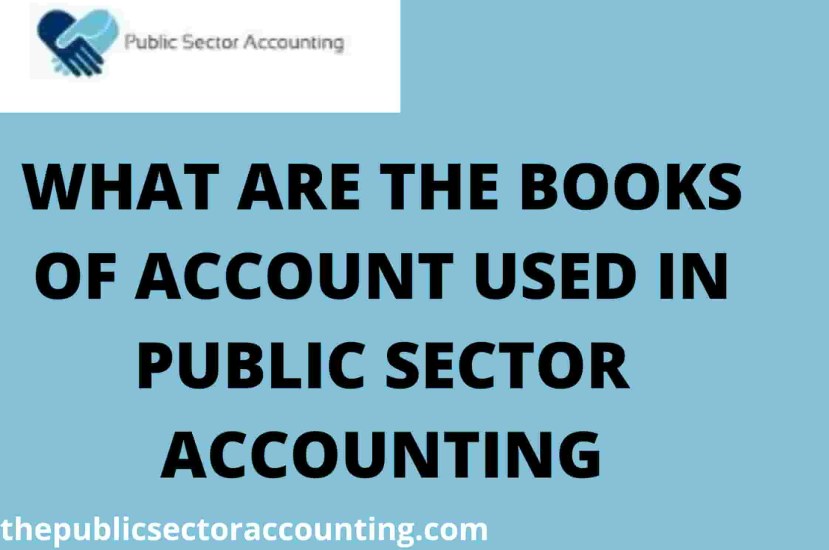The books of accounts in the public sector is a particular place where anything consider financial information for a certain public sector is collected.
The books of account used in the public sector accounting is where all the financial information are being recoreded for refrence and auditing purposes.
Read Also: WHAT ARE THE LEGAL BASIS OF PUBLIC SECTOR ACCOUNTING
The books of account used in the public secto accounting are as follows:
- Cashbooks
- Ledger and
- vote book
Summary of Contents
CASH BOOK
Recording here means the process of recording financial transactions and activities in the relevant books of accounts, such as the cash book, ledger, and vote book, is known as recording.
What Is a Cash Book, Exactly?
A cash book is a financial notebook that keeps track of all cash receipts and expenditures, including bank deposits and withdrawals. The cash book entries are subsequently entered into the general ledger.
What you should know about cash book
- A cash book is a division of the general ledger that records all cash transactions for a certain period.
- The cash book is kept in chronological order, and the balance is constantly updated and confirmed.
- The cash book is frequently divided into two components in larger organizations: the cash disbursement diary and the cash receipts notebook.
- A cash book varies from a cash account in that it is a separate ledger where cash transactions are recorded, whereas a cash account is a general ledger account.
- Single column, double column, and triple column cash books are the most frequent.
What Is a Cash Book and How Does It Work?
All cash transactions made during an accounting period are documented in chronological order in a cash book, which is set up as a subsidiary to the general ledger.
The cash book is frequently divided into two components in larger organizations: the cash distribution journal, which records all cash payments, and the cash receipts journal, which records all cash received into the company.
Payments made to vendors to lower accounts payable would be recorded in the cash disbursement journal, while payments made by customers on outstanding accounts receivable or cash sales would be recorded in the cash receipts journal.
Read Also: WHAT IS VIREMENT IN PUBLIC SECTOR ACCOUNTING
The major purpose of a cash book is to efficiently manage cash by making it simple to ascertain cash balances at any time and allowing managers and corporate accountants to successfully budget their cash when needed. Accessing cash information in a cash book is also considerably faster than tracing cash through a ledger.
LEDGER BOOK
After posting the journal entries, the ledger is the next step in compiling the financial books of accounts. It is created for posting and balancing monetary transactions that occur in the business during the financial year in a simplified form.
Separate ledger accounts are created to identify the dues and payments of the parties separately at the end of the year, which would be hard to track using simply journal entries because thousands of transactions took place with different parties during the year.
Classification of Ledger books
Ledgers are classified in a variety of ways.
The ledgers can alternatively be categorized into the two categories below:
Permanent Ledger: These are ledgers with opening and closing balances that are carried over from year to year.
Temporary Ledger: They don’t have an opening or closing balance, and the account is closed at the end of the year by transferring the amount to the profit and loss account.
The Different Types of Ledgers
1. Creditors’ Ledger/Bought Ledger: This ledger is created to keep track of credit purchase transactions, or the transactions of the parties who have purchased products on credit. It’s also known as a buy ledger.
2. Sales Ledger/Debtors Ledger: This ledger records the date-by-date transactions of debtors, or those to whom items have been depleted in credit. It aids in calculating the debtors’ due amount at the end of the year.
3. General Ledger: Except for the sales and purchase accounts, all other account entries are maintained in the general ledger. It is also known as a summary ledger since it includes all nominal and real accounts such as accounts receivable, inventory, cash, investment, machinery, and so on.
Various subsidiary ledgers are created to provide information to the general ledger, and then everything is summed up in the general ledger. As a result, this account is referred to as the “master account” or “primary account.”
4. Private Ledger: This sort of ledger is created to keep the proprietor’s personal records and is not intended for public scrutiny, such as capital account, current account, drawing account, personal loan account, and so on.
Importance of Ledger book
The following are some of the benefits of keeping a ledger:
- Calculation of profit/loss: For each commercial organization, ledger preparation is an unavoidable step in computing the actual profit or loss for the year. Every business must prepare a profit and loss statement in order to identify the true and fair position of its financial statements, which is impossible to do without first preparing the required ledger accounts.
- Exact account position: Ledger accounts show the exact account status at the moment of closing, whether the account has an outstanding or owing balance.
- Time saver: Because all of the entries are kept in one location, it’s quicker and faster to prepare other accounts like trading and profit and loss statements.
- Imperative: Any business organization must generate ledger accounts for all parties involved in every transaction in order to ensure the completeness or accuracy of the transactions that transpired during the year. Separate ledger accounts lessen the risk of missing a transaction because the ledger account will not be balanced if a transaction is missed.
VOTE BOOK
A vote book is a memoranda accounts book intended to track government expenditures and verify that no money is spent outside of the budget. The vote book is used to keep track of government spending, according to this definition.
A vote book is an accountancy book used in the public sector to track and record expenditure. The information in these records is audited to ensure that budgets are well-managed and in compliance with Financial Regulations.
The vote book system is used in public sectors such as government and schools to:
• Make sure there are no out-of-pocket expenses.
• Draw attention to out-of-the-ordinary spending that isn’t necessary.
• Display the available balance so that the company may stay on top of its finances.
• Make sure you have enough money set aside for future payments.
Regular audit checks are in place to ensure that the finances of the government or a school are utilized wisely and in the best interests of the institution. Any discrepancies will be recorded by the auditors and will be investigated further.
In theory, this rigorous methodology is designed to help corporations limit spending and manage their money. When we look at government spending in England, for example, the vote book system appears to have flaws.
Maintaining control over expenditure in the public sector necessitates the use of an accounts book. Individuals within organizations, on the other hand, must be willing to minimize costs and hold back on specific expenditures when necessary in order to thrive.
Note:
The public sector accounting posts, guides, or articles are not limited to these 10 countries alone:
- Ghana
- Nigeria
- United States
- Uganda
- India
- Kenya
- Philippines
- Malaysia
- Tanzania
- South Africa
But instead, it targeted all the countries in the world since public sector accounting is being practiced in every country in the world, so wherever country you are in the world, you can read public sector guides here since public sector accounting applications are similar.
Please leave a comment below





Leave a comment